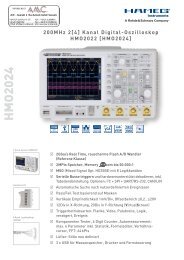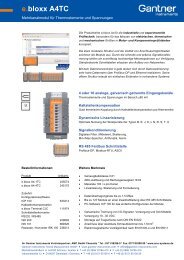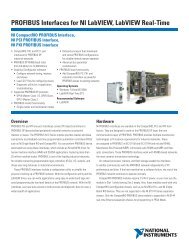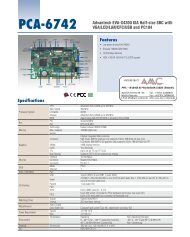GPIB Serial Port Controller/Converter
GPIB Serial Port Controller/Converter
GPIB Serial Port Controller/Converter
Create successful ePaper yourself
Turn your PDF publications into a flip-book with our unique Google optimized e-Paper software.
<strong>GPIB</strong> <strong>Serial</strong> <strong>Port</strong> <strong>Controller</strong>/<strong>Converter</strong><br />
NI <strong>GPIB</strong>-RS232<br />
• RoHS-compliant<br />
• Completely IEEE 488.2-compatible<br />
• Maximum data transfer rates (baud<br />
rates) of 115.2 kb/s; hardware<br />
handshaking and XON/XOFF<br />
protocols prevent data loss<br />
• Extends <strong>GPIB</strong> to cable lengths up to<br />
15.6 m (50 ft)<br />
• External 12 VDC universal power supply<br />
(100 to 240 VAC input)<br />
• Host configuration utility to configure<br />
mode of operation (software-selectable<br />
modes for compatibility with existing<br />
<strong>GPIB</strong>-232CT-A and <strong>GPIB</strong>-232CV-A)<br />
Overview<br />
• 4 modes of operation<br />
• S Mode – control <strong>GPIB</strong>-based<br />
instruments from your PC<br />
using RS232<br />
• G Mode – integrate an RS232<br />
instrument into your <strong>GPIB</strong> system;<br />
change serial parameters in software<br />
• C Mode – control a single <strong>GPIB</strong><br />
instrument through your RS232 port<br />
(simple protocol translation)<br />
• D Mode – interface an RS232<br />
instrument to a <strong>GPIB</strong> bus; configure<br />
serial parameters up front<br />
• Optional rack-mount and DIN-rail<br />
hardware kits<br />
The National Instruments <strong>GPIB</strong>-RS232 is a high-performance serialto-<strong>GPIB</strong><br />
interface. With it connected, a computer with an RS232<br />
serial port can be a talker, listener, or controller on the <strong>GPIB</strong> bus.<br />
The NI <strong>GPIB</strong>-RS232 can also interface RS232 instruments and<br />
peripherals to the <strong>GPIB</strong>.<br />
The <strong>GPIB</strong>-RS232 has all the software and logic required to implement<br />
the physical and electrical specifications of the IEEE 488 and RS232<br />
standards. It can interpret and execute high-level commands sent to it<br />
over the serial port, performing RS232-to-<strong>GPIB</strong> protocol conversions, as<br />
well as interpret commands sent over <strong>GPIB</strong>, performing <strong>GPIB</strong>-to-RS232<br />
protocol conversions. The <strong>GPIB</strong>-RS232 uses the TNT5004 controller chip,<br />
implementing all IEEE 488 talker/listener/controller functionality.<br />
Two protection mechanisms ensure that the <strong>GPIB</strong>-RS232 does not lose<br />
incoming serial data – data buffering and handshaking. The <strong>GPIB</strong>-RS232<br />
has an internal RAM buffer that stores incoming serial data until it<br />
can output the data to the <strong>GPIB</strong> port. The serial RAM buffer size is<br />
1 MB. When the serial RAM buffer is nearly full, the <strong>GPIB</strong>-RS232 can<br />
handshake with the serial host to stop data transmission. When more<br />
space is available in the buffer, the <strong>GPIB</strong>-RS232 can again handshake<br />
with the serial host to start data transmission. The <strong>GPIB</strong>-RS232 can<br />
use both the XON/XOFF software handshaking and the hardware<br />
handshaking protocols.<br />
Modes of Operation<br />
The <strong>GPIB</strong>-RS232 has four software-selectable modes of operation,<br />
ensuring compatibility with existing applications:<br />
S Mode<br />
Configure the <strong>GPIB</strong>-RS232 to operate in S Mode if your serial device acts<br />
as a controller in the <strong>GPIB</strong> system, addressing one or more devices, and<br />
performing other <strong>GPIB</strong> controller functions.<br />
G Mode<br />
Configure the <strong>GPIB</strong>-RS232 to operate in G Mode if your serial device<br />
acts only as a talker and/or listener while a <strong>GPIB</strong> controller manages<br />
the system, sending and receiving data to and from the serial device.<br />
D Mode<br />
Set the <strong>GPIB</strong>-RS232 to operate in D Mode to connect a serial device<br />
to a <strong>GPIB</strong> system with a <strong>GPIB</strong> controller responsible for addressing the<br />
<strong>GPIB</strong>-RS232 to talk or listen.<br />
C Mode<br />
Set the <strong>GPIB</strong>-RS232 to operate in C Mode when transferring data<br />
between a single <strong>GPIB</strong> device with no controller capabilities and<br />
a serial device.
<strong>GPIB</strong> <strong>Serial</strong> <strong>Port</strong> <strong>Controller</strong>/<strong>Converter</strong><br />
Specifications<br />
IEEE 488 Compatibility<br />
IEEE 488.1 and IEEE 488.2 compatible<br />
Data Transfer Rate<br />
RS232 .................................................. Up to 115.2 kb/s<br />
Physical<br />
Dimensions.......................................... 16.01 by 9.35 by 3.15 cm<br />
(6.30 by 3.68 by 1.24 in.)<br />
Weight................................................. 192 g (6.75 oz)<br />
Connectors<br />
<strong>GPIB</strong> .................................................... IEEE 488 24-pin<br />
RS232 .................................................. DB-9 male<br />
DC power ............................................ Coaxial plug (single output<br />
models) 5.5 mm outer diameter,<br />
2.1 mm inner diameter,<br />
11 mm length, center “+”<br />
Power Requirements<br />
Input voltage range............................. 9 to 28 VDC<br />
Current consumption (@12 VDC)........ 800 mA max, 300 mA typical<br />
Internally fused (nonreplaceable) ....... F 2.2 A 125 V (fast-acting)<br />
12 VDC power supply (included)<br />
Input voltage/current range ........... 100 to 240 VAC, 0.4 A,<br />
47 to 63 Hz<br />
Operating Environment<br />
Ambient temperature.......................... 0 to 55 °C<br />
(Note: For the <strong>GPIB</strong>-RS232 to operate over the entire specified ambient temperature range,<br />
stacking the product is not recommended.)<br />
Relative humidity ................................ 10 to 90%, noncondensing<br />
Maximum altitude............................... 2,000 m (at 25 °C<br />
ambient temperature)<br />
Pollution degree.................................. 2<br />
Indoor use only (in accordance with IEC-60068-2-1, IEC-60068-2-2, and IEC-60068-2-56).<br />
Storage Environment<br />
Ambient temperature.......................... -20 to 70 °C<br />
Relative humidity ................................ 5 to 95%, noncondensing<br />
(in accordance with IEC-60068-2-1, IEC-60068-2-2, and IEC-60068-2-56)<br />
Shock and Vibration<br />
Operational shock ............................... 30 g peak, half-sine,<br />
11 ms pulse<br />
(in accordance with IEC-60068-2-27; test profile developed in accordance with MIL-PRF-28800F)<br />
Random Vibration<br />
Operating............................................. 5 to 500 Hz, 0.3 grms<br />
Nonoperating ...................................... 5 to 500 Hz, 2.4 grms<br />
(in accordance with IEC-60068-2-64; test profile developed in accordance with MIL-PRF-28800F,<br />
Class 3)<br />
Compliance and Safety<br />
Online at ni.com/certification<br />
Ordering Information<br />
NI <strong>GPIB</strong>-RS232<br />
U.S. 120 VAC ......................................................................779732-01<br />
Universal Euro 240 VAC ......................................................779732-04<br />
North American 240 VAC....................................................779732-05<br />
United Kingdom 240 VAC....................................................779732-06<br />
Japanese 100 VAC ..............................................................779732-07<br />
ni.com/gpib.<br />
2







